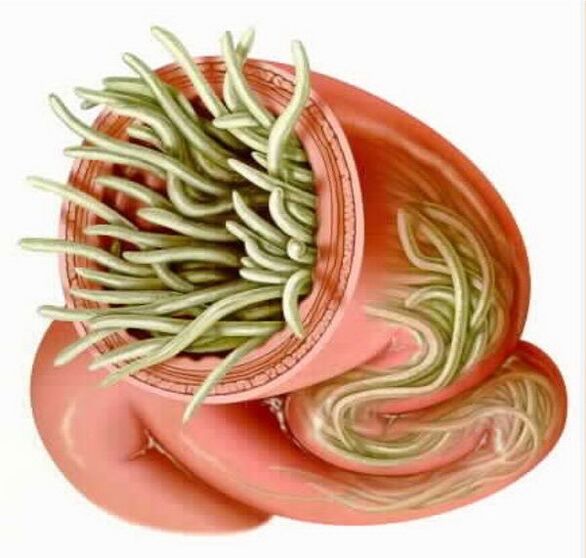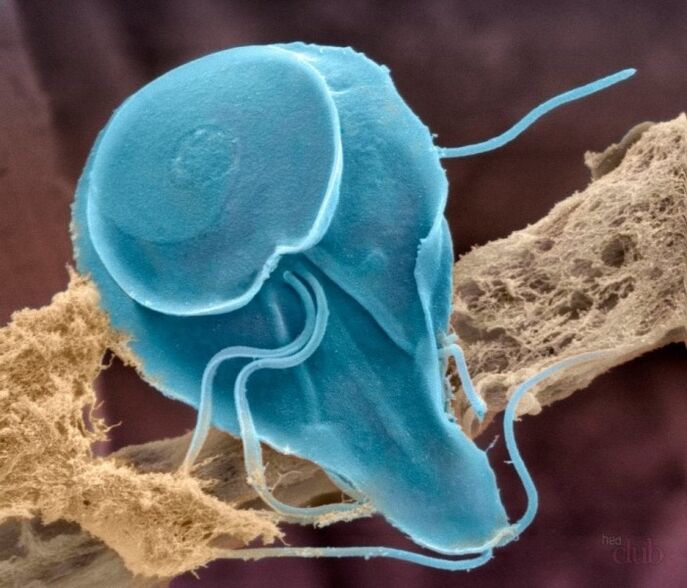Parasites in the human bodyappear completely unexpectedly. The reason for this usually becomes direct contact with the source of infection, for example, with an infected person or object. There are many types of parasites that can settle in the human body: it can be lamblia, pinworms, alveococci, trichinella, schistosomes, etc.
Parasites in the human body

The human body has a rather complex structure, which is susceptible to various diseases and infections, infections, viruses, and parasites. Parasites that settle in the human body are microorganisms that lead a parasitic lifestyle, trying to survive by feeding on other organisms, microorganisms, cells, etc.
Parasites that live in the human body are microorganisms that lead a parasitic lifestyle, trying to survive by feeding on other organisms, microorganisms, cells, etc.
Parasites that find fertile ground for life and reproduction in the human body, cause very serious, sometimes irreparable harm to his health, destroy the body from the inside, eat it and sometimes lead to the death of a person, or stop the work of individual organs, which also worsens the qualitylife of a person, depresses and, in the end, shortens his life.
There are millions of species of parasitic worms in nature. Of these, there are those that parasitize only one representative of the animal world. But in nature there are also species that can exist in the body of several species of animals. What parasites live in the human body is a question that many people ask.
A huge variety of helminth species can live in the human body. Some of them are very rare, while others very often settle inside and can lead a parasitic lifestyle for up to several decades.
Varieties of parasitism
There are the following types of parasitism: ectoparasitism - parasites that lead a superficial lifestyle on the human body. This category includes lice, bugs, ticks; endoparasitism - parasites that affect the internal organs of a person. They, in turn, are divided into two large groups of protozoa and helminths.
Types of parasitic protozoa: lamblia, toxoplasma, trichoionada. These types of protozoan parasites are most often found in the human body.
Classification of parasites related to helminths implies their division into three large groups: nematodes; trematodes; cestodes.
Types of parasites in the human body
Pinworms
Pinworms are the most known parasites in the intestines. The disease caused by pinworms is called enterobiasis. Not only people suffer from it, but also great apes. Children are at increased risk of pinworm infection. According to various sources, the level of their involvement in enterobiasis at preschool age ranges from 25 to 90%. Pinworms are passed from one person to another. Infection occurs through a handshake, clothes and any objects touched by a sick person, provided that after contact the hands were not washed and pinworm eggs got into the mouth (this happens especially often during meals).
Flies and cockroaches can carry the eggs of these nematode worms by seeding their food. Pinworms live in the small intestine, in the cecum, in the colon. They mate in the ileum, after which the female crawls out of the anus through the rectum and lays eggs in the anus.
Symptoms of enterobiasis are itching in the anus, intoxication of the body (allergic reactions, exhaustion, fatigue), anemia, an increase in the level of eosinophils in the blood, insomnia, and abdominal pain.
In order to get rid of enterobiasis, anthelmintic drugs are used. The dosage and course of treatment is selected by the doctor. To avoid re-infection, it is important to keep your hands clean, wash them after visiting any public places, after using the toilet, before eating, etc.
Nails should be cut short, bed and underwear should be thoroughly disinfected, and the apartment should be cleaned daily.
Toksokara
Toxocara is a parasite from the nematode group. The disease caused by toxocara is called "toxocariasis". This invasion in humans can be larval (ocular and visceral), as well as intestinal. The disease is widespread throughout the world. Toxocara infection occurs when the eggs of the worm enter the human digestive tract. This is most commonly seen when eating food or water that is contaminated with dog feces. Contact with sick animals is no less dangerous.
Cats and dogs, foxes and wolves are natural carriers of Toxocara. Once in the human body, the larva of the worm migrates through the blood vessels and can settle in any organ. The symptoms of the disease will depend on this. Most often, toxocariasis manifests itself in the form of allergic reactions (Quincke's edema, skin rash, bronchial asthma). During an exacerbation of the disease, the body temperature may increase up to 38 degrees, but the symptoms of intoxication of the body are weakly expressed.
Toxocariasis can be suspected by enlarged lymph nodes: the visceral form of toxocariasis is the most common, occurs with damage to internal organs (intestines, respiratory system, heart valves).
A person may experience pain in the abdomen, in the right hypochondrium, dyspeptic disorders, nausea; if the respiratory system is damaged, a person has shortness of breath, dry cough, attacks of suffocation; if toxocars settle on the heart valves, then the patient has weakness, blue fingers and nasolabial triangle, shortness of breath; the skin form is characterized by itching, a feeling of movement under the skin, inflammation of the skin and mucous membranes; in the neurological form, the parasite provokes the development of inflammation of the meninges and the brain tissues themselves.
It manifests itself in headaches, nausea and vomiting, seizures and other neurological disorders. For the treatment of toxocariasis, anthelmintic drugs are used, as well as pathogenetic and symptomatic therapy.
Human Ascaris
Human Ascaris is a roundworm that parasitizes the small intestine. The disease that these parasites provoke is called ascariasis. The owner of the roundworm and the source of infection is a sick person. Together with his feces, the eggs of the worms enter the soil, where they mature to larvae. Then this soil is transferred to food or to human hands, and if the rules of personal hygiene are not observed and if fruits, vegetables and berries are poorly processed, it is transferred to the digestive tract.
Children and rural residents are more susceptible to infection. Ascariasis manifests itself in different phases of its development in different ways. In the phase of migration of larvae through the body, an increase in body temperature occurs, a dry cough appears, wheezing in the lungs, and lymph nodes increase in size. Children suffer ascariasis more severely than adults.
Allergic skin reactions are a characteristic symptom of ascariasis. During parasitism in the intestines, the patient develops dyspeptic disorders, loose stools are replaced by constipation, frequent abdominal pains, nausea and vomiting occur. On the part of the nervous system, hysterical seizures, insomnia, mental fatigue, and headaches are observed.
For the treatment of ascariasis in the stage of larval migration, patients are prescribed some anthelmintic drugs, while worms are parasitizing in the intestines, others.
Hookworm and nekator
Hookworm and nekator are two types of roundworms that belong to the Ancylostomatidae family and cause a disease called hookworm. There are two ways of infecting the human body with these parasites - fecal-oral (drinking contaminated water, fruits, vegetables) and percutaneous in contact with soil (penetration occurs through the skin).
Clinical symptoms of ankylostomiasis: papular vesicular rash, shortness of breath and cough, loss of appetite, nausea, abdominal pain, loose stools, iron deficiency anemia. Treatment is reduced to taking anthelmintic drugs and to eliminate anemia with iron preparations.
Wide ribbon
Broad tapeworm refers to tapeworms from the order Pseudophyilidea. These parasites live in the small intestine of humans and those mammals that consume fish. Infection with a tapeworm provokes the development of a disease such as diphyllobothriasis.
There are 12 types of tapeworms that can parasitize the human body, however, the widest tapeworm is the most common. Infection occurs when eating raw and thermally unprocessed lightly salted fish or caviar, which contains worm eggs. Symptoms of the presence of the parasite in the intestines: nausea, abdominal pain, anemia.
In severe cases, intestinal obstruction develops. To get rid of the parasite, patients are prescribed antiparasitic drugs. After the completion of the therapeutic course, a second study is mandatory for the presence of a worm in the body. If necessary, the use of anthelmintic drugs is repeated.
Bull tapeworm
Bull tapeworm is a tapeworm belonging to the teniid family. In the larval stage, it affects cattle, and in the tapeworm stage it lives in the human body (in its intestines). The tapeworm provokes a disease called teniarinchiasis, as a rule, one parasite is present in the patient's body. Human infection occurs through the alimentary route after eating poorly heat-treated meat (beef).
Clinically, the disease is manifested by nausea, excessive appetite, pain in the abdomen, unstable stools, and allergic reactions of the urticaria type. To remove the bovine tapeworm from the body, an anthelmintic agent is prescribed. In parallel, the patient should adhere to a slag-free diet, put cleansing enemas, take laxatives. After using an anthelmintic agent, the worm dies and leaves the human body naturally. Sometimes its length can be up to 12m.
Pork tapeworm
Pork tapeworm is a parasitic tapeworm that infects mammals. Intermediate carriers can be pigs, dogs, rabbits, camels, but the ultimate owner is always a man.
If an adult parasite is found in a person's body, then they talk about such a disease as teniasis. When the parasite is in the patient's body in the larval stage, the disease is called "cysticercosis".
Pork tapeworm infection occurs when thermally unprocessed pig meat is eaten. Sometimes the sources of the cysticercini are seeding hands or water. A patient with teniasis poses an epidemiological danger both to himself (infection by larvae of the brain, skin, eyes or skeletal muscles) and to others.
Symptoms of teniasis: abdominal pain, loss of appetite, upset stools, headaches, frequent dizziness, fainting (extremely dangerous is teniasis of the brain and eyes). For the treatment of teniasis, the patient is placed in a hospital. Under the supervision of doctors, he is prescribed anthelmintic drugs, after which, after 2 hours, the patient takes a saline laxative, which allows him to get rid of the segments and eggs of the worm. For the treatment of cysticercosis of the eyes and brain, surgical intervention is necessary.
Echinococcus
Echinococcus is a tapeworm from the order Cyclophyllidae. Adults parasitize in the intestines of dogs and cats, and are found in jackals and wolves. For humans, parasite larvae are dangerous, which can cause a serious disease - echinococcosis. Larvae can infect the internal organs of a person, forming echinococcal cysts in them. For echinococci, humans act as an intermediate host.
Infection is carried out by contact (in the process of cutting carcasses, when interacting with a sick animal), or alimentary (when eating contaminated food or water). At risk are people who are engaged in animal husbandry or who have constant contact with animals. Symptoms may not appear for many years.
When the asymptomatic stage ends, pains, skin itching, and urticaria appear at the site of the larva's invasion. In addition, the functioning of the organ inside which the echinococcus larva parasitizes suffers. An increase in body temperature and fever is observed during cyst suppuration.
A complete cure for echinococcosis is possible only by surgery. The cyst is husked, trying not to damage its shell. If the bladder is very large, then it is punctured and the contents are sucked out. Before and after the operation, the patient is prescribed antiparasitic drugs. In the case of radical removal of the cyst, the prognosis for recovery is favorable.
Alveococcus
Alveococcus is a helminth from the cestode group. The worm cries out a life-threatening disease of alveococcosis, which is characterized by the formation of a primary focus in the liver with the subsequent spread of metastases to other organs. Infection occurs when oncospheres of the parasite enter the mouth.
This can occur during hunting, in the process of cutting carcasses of wild animals, in contact with domestic animals, or when eating unprocessed berries and herbs from the forest. Symptoms of alveococcosis are reduced to pain in the right hypochondrium, belching, nausea. Often there is itching, allergic reactions. Suppuration of a tumor with a parasite and its breakthrough into the abdominal or pleural cavity is not excluded.
Alveococcus metastases can be found in the brain and lungs. Treatment of the disease is prompt, but should be supplemented by the intake of antiparasitic drugs.

Giardia
Giardia (another name for Giardia) is a flagellate parasite belonging to the Diplomonadid order. Giardia causes a disease called "giardiasis" and parasitizes in the small intestine of humans, as well as many other mammals and even birds.
Giardia infection occurs through the fecal-oral route: food, water and contact-household methods. The most important in terms of transmission is the use of raw water, contaminated food, the use of public items seeded with Giardia cysts. The leading symptoms of giardiasis are nausea, painful sensations in the abdomen, stool disturbances, and excessive gas.
In addition, patients suffer from allergic reactions, intoxication and neurotic disorders. Therapy of giardiasis is carried out with the help of antiprotozoal drugs, as well as with the inclusion of enzymes, choleretic agents and enterosorbents in the treatment regimen.
Histological amoeba
Histological amoeba is a protozoal parasite that causes a disease called amoebiasis. The disease is manifested by the formation of ulcers in the large intestine, followed by damage to other internal organs. Infection with amoebas occurs through the fecal-oral route, after mature cysts from water or food enter the human gastrointestinal tract. Possible contact transmission of parasites through unwashed hands. Flies can be carriers of amoebas.
Another way of spreading amoebiasis is through the sexual route (anal intercourse). Symptoms of amebiasis: profuse mucous stools, abdominal pain, blood in the stool, weight loss, anemia. In addition, extraintestinal amebiasis is characterized by the formation of abscesses in those organs that are affected by parasites (lungs, brain, liver, etc. ).
Antiprotozoal drugs are prescribed to treat intestinal ambiasis.
The duration of therapy is determined by the severity of amoebiasis.
A disease called gnatostomosis is caused by larvae and sexually mature nematodes Gnathostoma spinigerum. Infection occurs when eating unprocessed fish, frog or bird meat, as well as drinking unboiled, non-disinfected water. Symptoms of the disease are manifested in cough and pain at the site of penetration of the larva under the skin, in local inflammation and an increase in body temperature.
Severe edema and itching are typical. As a rule, after a week from the onset of symptoms, they disappear, but they recur again over the years. Dangerous damage to the eyeball and the brain, it is often fatal. Treatment involves taking anthelmintic drugs and surgery. During the operation, parasites are removed from under the skin.
Trichinella

Trichinella are round parasitic worms that in the larval stage live in the muscles (oculomotor, masticatory, diaphragm muscles), and in adulthood - in the lumen of the small intestine. The disease provoked by trichinella is called "trichinosis". It is deadly.
Human infection occurs through the consumption of raw or poorly processed meat from wild and domestic animals. Symptoms include loss of appetite, vomiting, diarrhea, and abdominal pain. In the future, muscle pains, swelling of the eyelids, and skin rashes join. Treatment of parasitic infestation is carried out with the help of anthelmintic drugs. At the same time, antihistamines are prescribed, and corticosteroids as needed.
Schistosomes
Schistosomes are fluke worms of the genus trematodes. They provoke a disease called schistosomiasis. Human infection occurs during bathing, in the process of washing clothes or watering the ground with water with schistosom larvae. They are able to penetrate into the human body even through the entire skin and mucous membranes. Symptoms in the acute stage of the disease are manifested in a rise in temperature to high levels, in itchy skin and in the appearance of papules all over the body.
They are able to penetrate into the human body even through the entire skin and mucous membranes. Symptoms in the acute stage of the disease are manifested in a rise in temperature to high levels, in itchy skin and in the appearance of papules all over the body.
After the disease becomes chronic, the infected person may show signs of colpitis, prostatitis, colitis, ascites, hydronephrosis, etc. Anthelmintic drugs are used to treat the disease. Surgical intervention is required for complications of genitourinary schistosomiasis.
There are many parasites that can harm the human body. Most of them enter the body of their owner through the gastrointestinal tract if safe food preparation technology is not followed and basic hygiene procedures are not followed.
Parasites in the body - adaptive properties
- long life expectancy (helminths live in the human body for years, and sometimes as long as the host of the parasite lives);
- the ability to suppress or modify the immune response of the host organism (a state of immunodeficiency arises, conditions are created for the penetration of pathogenic agents from the outside, as well as for “disinhibition” of internal foci of infection);
- many types of helminths, entering the digestive tract, release antienzymes, which saves them from death; the digestion process is disrupted, toxic-allergic reactions of various severity appear: urticaria, bronchial asthma, atopic dermatitis;
- stages of development (egg, larva, change of hosts);
- the ability of eggs to survive for years in the external environment;
- sexual reproduction, in which there is an exchange of genetic information, and this is already the highest stage of development, leading to an increase in the heterogeneous population, that is, parasites become less vulnerable;
- lack of methods of immunization, as the immune response is weak and unstable;
- wide distribution of helminths, many habitats (water, soil, air, plants and animals).
Prevention of parasites in the body
Preventive measures to prevent infestation of parasites should be comprehensive. First of all, it is necessary to follow the basic rules of personal hygiene, eat only washed fruits, vegetables, as well as heat-treated fish and meat, drink only clean water.
Most experts advocate the drug prevention of helminthiasis using pharmaceutical antiparasitic drugs - a parasitologist will help you to choose the necessary medicine and correctly calculate its dosage.
You can supplement this therapy with folk remedies that have an anthelmintic effect - for example, eat more onions, garlic, various spices, regularly eat pumpkin seeds.























